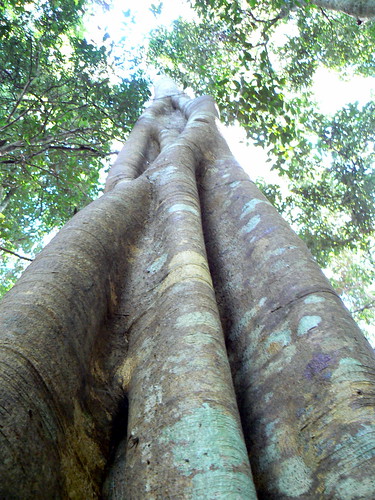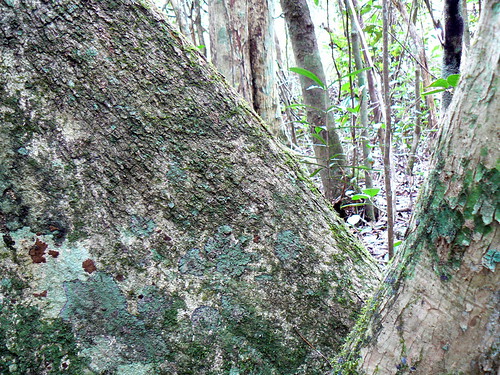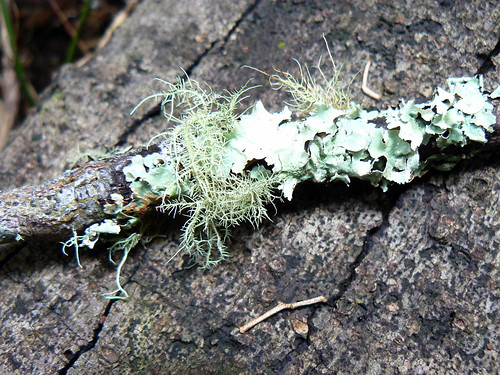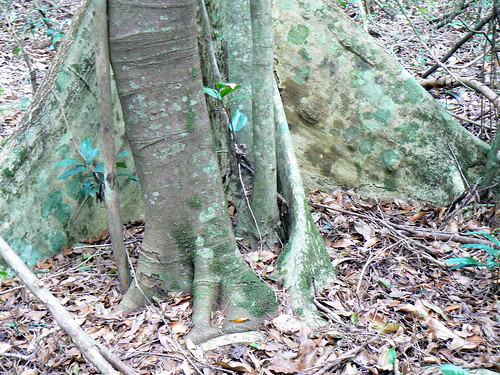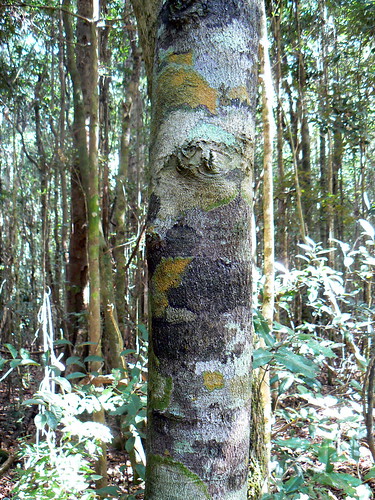Deep down on the forest floor, sunlight is the scarcest of all resources for plants. They struggle to reach it, lianas and vines climbing up to reach the top and seedlings exploit a gap in the canopy to shoot up and out-compete other plants. But some species have evolved a way to do without sunlight entirely. These plants don't photosynthesise at all. They have no (or very few non-functional) chloroplasts and so lack the green colouration associated with plants.
Instead, they "steal" the carbon they require from fungi, and frequently, indirectly through fungi from other plants. Plants that parasitise fungi are called myco-trophic (myco=fungal, trophic=relating to feeding or nutrition).
 |
| The Australian orchid, Rhizanthella gardneri, does not photosynthesise, but relies on its fungal host for nutrients and carbon. Photo: Bert Wells, WA Government Recovery Plan. |
80% of land plant families are mycorrhizal, having a symbiotic relationship with fungi. Normally, the relationship is mutualistic, with the plant providing the fungus with energy by way of carbon products from photosynthesis, and the fungus supplying the plant with nutrients from the soil such as nitrogen and phosphorous; see (a) in figure below. Species such as the orchid Rhizanthella gardneri, above, "cheat" on this relationship, taking both nutrients and carbon from the host mycorrhizae; see (b). Because many mycorrhizal fungi and their hosts are generalists, sometimes an entire underground network of hyphae from a single fungus connects multiple individual plants of different species. So while the "cheater" parasitises the fungus, its ultimate hosts are the other mutualistic plants in the network, with the fungus acting as a bridge.
Of course, sometimes fungi are pests of plants and take nutrients away from the plant. In (c) we see how that works. Carbon and nutrients are obtained by a pathogenic fungus. But here, the tables are turned. Another plant is parasitising the parasitic fungus. It's an epiparasite: the parasite of a parasite.
So far, the process is relatively straightforward. The parasitic plant is simply exploiting mechanisms that have evolved many times in plant evolution, the elegant, microscopic interaction of plant root cells and fungal hyphae. It's an example of how mutualisms can be unstable, able to switch to parasitism as environmental pressures alter. As with much in biology, it represents the ongoing "arms race" that occurs between species competing for resources.
The fourth mode (d), is a little understood but quite extraordinary relationship: the recruitment by a plant of a fungal host that is normally free-living. In this case, the fungi is saprotrophic: it obtains its nutrients by digesting dead plant material, such as logs.
 |
| © Margaret Morgan |
Saprotrophic fungi are a common sight in forests and woodlands. Their fruiting bodies (the "mushrooms") are frequently seen growing out of dead logs or leaf litter, but most of the organism is beneath the surface, masses of filamentous hyphae exuding enzymes to break down the organic material.
 |
| Mycena galericulata, a saprotrophic fungus growing on a dead log. Image (CC) by Dan Molter, Wikimedia. |
 |
| Gastrodia confusa, Taiwan. Image © JJ-Merry. Reproduced with permission. |
For many years, it has been assumed that plants in this genus were
themselves saprophytes, gaining nutrients directly from decaying organic
matter. Indeed, this claim is still made. Molecular studies employing isotopes
of carbon and nutrients have now shown that in this species at least, the
fungal host is playing an essential role. Gastrodia species
are broadly distributed from Africa and India, to South-East Asia, Australia
and Pacific islands. Three species are endemic to New
South Wales. It would be fascinating to establish whether in these species
myco-heterotrophy is also occurring.
I'd bet good money that it is.
I'd bet good money that it is.
_____________________________________________
This post is adapted from a scientific poster I made for BIOL341 Parasitology, a unit at Macquarie University convened by Dr Michelle Power.
Special thanks to JJ-Merry for permission to include his image of Gastrodia confusa. There are very few images of this species online, and most are his work. His excellent photography of South-East Asian tropical plants can be found here.
This post is adapted from a scientific poster I made for BIOL341 Parasitology, a unit at Macquarie University convened by Dr Michelle Power.
Special thanks to JJ-Merry for permission to include his image of Gastrodia confusa. There are very few images of this species online, and most are his work. His excellent photography of South-East Asian tropical plants can be found here.
References:
Bidartondo, MI 2005, 'The evolutionary ecology of myco-heterotrophy', New Phytologist, vol. 167, no. 2, pp. 335-52.
Bidartondo, MI, Redecker, D, Hijri, I, Wiemken, A, Bruns, TD,
Dominguez, L, Sérsic, A, Leake, JR, Read, DJ 2002, 'Epiparasitic plants
specialized on arbuscular mycorrhizal fungi', Nature, vol. 419, no.
6905, pp. 389-92.
Hibbett, DS 2002, 'When good relationships go bad', Nature,
vol. 419, no. 6905, p. 345.
Kikuchi, G, Higuchi, M, Yoshimura, H, Morota, T, Suzuki, A 2008,
'In vitro symbiosis between Gastrodia elata Blume
(Orchidaceae) and Armillaria Kummer (Tricholomataceae) species
isolated from the orchid tuber', Journal of Japanese Botany, vol.
83, no. 2, p. 77.
Leake, JR 2005, 'Plants parasitic on fungi: unearthing the fungi in myco-heterotrophs and debunking the 'saprophytic' plant myth', Mycologist, vol. 19, no. 3, pp. 113-22.
Leake, JR 2005, 'Plants parasitic on fungi: unearthing the fungi in myco-heterotrophs and debunking the 'saprophytic' plant myth', Mycologist, vol. 19, no. 3, pp. 113-22.
Merckx, V, Bidartondo, MI , Hynson, NA 2009, 'Myco-heterotrophy:
when fungi host plants', Annals of botany, vol. 104, no. 7, pp.
1255-61.
Ogura-Tsujita, Y, Gebauer, G, Hashimoto, T, Umata, H, Yukawa, T
2009, 'Evidence for novel and specialized mycorrhizal parasitism: the
orchid Gastrodia confusa gains carbon from saprotrophic Mycena', Proceedings
of the Royal Society B: Biological Sciences, vol. 276, no. 1657, pp. 761-7.
